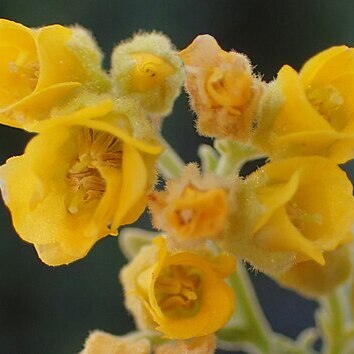Laxly, but copiously branched suffrutex, 0.3-1.2 m high; branches, grey-brown; new growth and vegetative parts velvety grey-tomentose. Leaves petiolate, oblong-cuneate to suborbicular, apex truncate or rounded, margins crenate in upper 1/2 or at apex only, base cuneate or rounded; velvety tomentose on both surfaces. Stipules subulate, never leaf-like. Inflorescences of compound cymes, terminal on upper branchlets; peduncles and pedicels velvety tomentose. Flowers secund, often crowded, small, 3.0-4.5 mm long, yellow. Calyx obconical, 5-10-ribbed, 5-toothed in upper 1/3, sinuses wide; stellate-tomentose. Petals oblong, lower 1/3 narrowed into a claw. Flowering time Aug.-May. Fruit a subglobose capsule, surrounded by persistent calyx.
Grey-mealy, twiggy shrub to 1.5 m. Leaves grey-velvety, obovate to oblanceolate, toothed above. Flowers small, in crowded, secund, spreading, racemose clusters, yellow.

